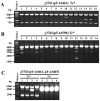Improving Salmonella vector with rec mutation to stabilize the DNA cargoes
- PMID: 21303535
- PMCID: PMC3047425
- DOI: 10.1186/1471-2180-11-31
Improving Salmonella vector with rec mutation to stabilize the DNA cargoes
Abstract
Background: Salmonella has been employed to deliver therapeutic molecules against cancer and infectious diseases. As the carrier for target gene(s), the cargo plasmid should be stable in the bacterial vector. Plasmid recombination has been reduced in E. coli by mutating several genes including the recA, recE, recF and recJ. However, to our knowledge, there have been no published studies of the effect of these or any other genes that play a role in plasmid recombination in Salmonella enterica.
Results: The effect of recA, recF and recJ deletions on DNA recombination was examined in three serotypes of Salmonella enterica. We found that (1) intraplasmid recombination between direct duplications was RecF-independent in Typhimurium and Paratyphi A, but could be significantly reduced in Typhi by a ΔrecA or ΔrecF mutation; (2) in all three Salmonella serotypes, both ΔrecA and ΔrecF mutations reduced intraplasmid recombination when a 1041 bp intervening sequence was present between the duplications; (3) ΔrecA and ΔrecF mutations resulted in lower frequencies of interplasmid recombination in Typhimurium and Paratyphi A, but not in Typhi; (4) in some cases, a ΔrecJ mutation could reduce plasmid recombination but was less effective than ΔrecA and ΔrecF mutations. We also examined chromosome-related recombination. The frequencies of intrachromosomal recombination and plasmid integration into the chromosome were 2 and 3 logs lower than plasmid recombination frequencies in Rec+ strains. A ΔrecA mutation reduced both intrachromosomal recombination and plasmid integration frequencies.
Conclusions: The ΔrecA and ΔrecF mutations can reduce plasmid recombination frequencies in Salmonella enterica, but the effect can vary between serovars. This information will be useful for developing Salmonella delivery vectors able to stably maintain plasmid cargoes for vaccine development and gene therapy.
Figures




Similar articles
-
Rec-dependent and Rec-independent recombination of plasmid-borne duplications in Escherichia coli K12.Mol Gen Genet. 1985;199(3):518-23. doi: 10.1007/BF00330768. Mol Gen Genet. 1985. PMID: 2993800
-
Single Strand Annealing Plays a Major Role in RecA-Independent Recombination between Repeated Sequences in the Radioresistant Deinococcus radiodurans Bacterium.PLoS Genet. 2015 Oct 30;11(10):e1005636. doi: 10.1371/journal.pgen.1005636. eCollection 2015 Oct. PLoS Genet. 2015. PMID: 26517555 Free PMC article.
-
Multiple pathways of duplication formation with and without recombination (RecA) in Salmonella enterica.Genetics. 2012 Oct;192(2):397-415. doi: 10.1534/genetics.112.142570. Epub 2012 Aug 3. Genetics. 2012. PMID: 22865732 Free PMC article.
-
[The genetic Rec system of homologous recombination in Escherichia coli].Genetika. 1986 Nov;22(11):2560-71. Genetika. 1986. PMID: 3542703 Review. Russian.
-
rec genes and homologous recombination proteins in Escherichia coli.Biochimie. 1991 Apr;73(4):523-32. doi: 10.1016/0300-9084(91)90124-j. Biochimie. 1991. PMID: 1911953 Review.
Cited by
-
Efficient generation of influenza virus with a mouse RNA polymerase I-driven all-in-one plasmid.Virol J. 2015 Jun 22;12:95. doi: 10.1186/s12985-015-0321-5. Virol J. 2015. PMID: 26093583 Free PMC article.
-
Multicopy integration of mini-Tn7 transposons into selected chromosomal sites of a Salmonella vaccine strain.Microb Biotechnol. 2015 Jan;8(1):177-87. doi: 10.1111/1751-7915.12187. Epub 2014 Dec 9. Microb Biotechnol. 2015. PMID: 25488129 Free PMC article.
-
A biologically conjugated polysaccharide vaccine delivered by attenuated Salmonella Typhimurium provides protection against challenge of avian pathogenic Escherichia coli O1 infection.Pathog Dis. 2017 Nov 30;75(8):ftx102. doi: 10.1093/femspd/ftx102. Pathog Dis. 2017. PMID: 28911037 Free PMC article.
-
New technologies in developing recombinant attenuated Salmonella vaccine vectors.Microb Pathog. 2013 May;58:17-28. doi: 10.1016/j.micpath.2012.10.006. Epub 2012 Nov 8. Microb Pathog. 2013. PMID: 23142647 Free PMC article. Review.
-
A Bacterial mRNA-Lysis-Mediated Cargo Release Vaccine System for Regulated Cytosolic Surveillance and Optimized Antigen Delivery.Adv Sci (Weinh). 2023 Nov;10(33):e2303568. doi: 10.1002/advs.202303568. Epub 2023 Oct 22. Adv Sci (Weinh). 2023. PMID: 37867213 Free PMC article.
References
Publication types
MeSH terms
Substances
Grants and funding
LinkOut - more resources
Full Text Sources
Other Literature Sources
Research Materials

